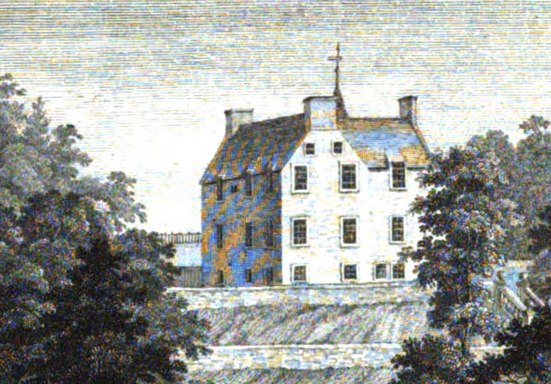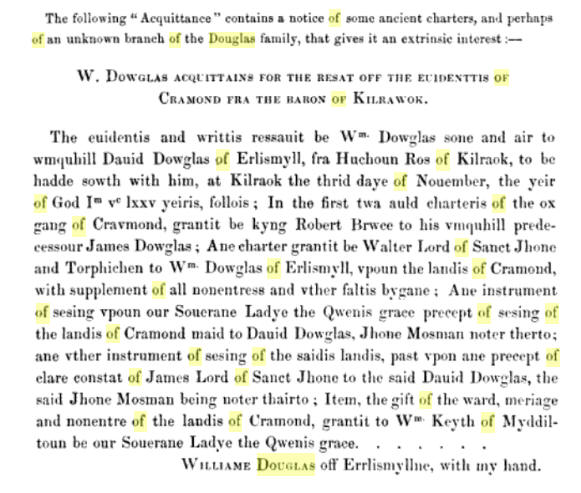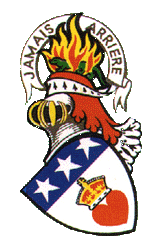Cramond Regis
 Cramond Regis, or King's Cramond, is said to have been a royal
hunting seat. In 1316 or 1320 it was given by Robert the Bruce,
along with the neighbouring property of Muirhouse, to Sir William
Oliphant of Aberdalgie, as compensation for lands in Kincardineshire
taken by John Balliol. Oliphant was a loyal supporter of Bruce, and
his son, Sir Walter Oliphant, would later marry Bruce's daughter
Elizabeth.
Cramond Regis, or King's Cramond, is said to have been a royal
hunting seat. In 1316 or 1320 it was given by Robert the Bruce,
along with the neighbouring property of Muirhouse, to Sir William
Oliphant of Aberdalgie, as compensation for lands in Kincardineshire
taken by John Balliol. Oliphant was a loyal supporter of Bruce, and
his son, Sir Walter Oliphant, would later marry Bruce's daughter
Elizabeth.
From the 14th to the 17th centuries Cramond Regis
passed through the hands of many families, the principle ones being
the Cramonds of Cramond, the Mowbrays of Cammo, the Logans of
Craighouse and the Logies of Logiesland. Some of these families
would have been responsible for substantial building work, as by
1791 Cramond Regis had the appearance of a much-altered L-plan tower
house of the 16th or 17th centuries.
On 20 October 1579, Andrew Howeston (attorney or procurators) was
suiter for William Douglas of Cramond Regis.
Sir John Smith of Grothill and Kings Cramond (c. 1600 – c. 1675) was
a 17th-century Scottish landowner and merchant who served as Lord
Provost of Edinburgh from 1643 to 1646. His estate was broken
and sold in 1676 which implies he died in debt, with no heritable
assets.
In 1718 John
Douglas-Hamilton, the first Earl of Ruglen, bought King's Cramond,
as it was then known, adding it to his neighbouring property Barnton
and combining them into one estate.
Hamilton was succeeded in
1744 by his daughter, Lady Anne Hamilton, Countess of Ruglen, the
widow of William Douglas, the
2nd Earl of March. King's Cramond and Barnton passed to their
son, William Douglas,
the 4th Duke of Queensberry and 3rd Earl of March, upon his
mother's death in 1748, but he sold it in 1770 to John Campbell,
Viscount Glenorchy, the son of John Campbell, the 3rd Earl of
Breadalbane.
Campbell died in 1771, and his wife Willielma
lived part time at Barnton before selling the combined estate to
William Ramsay, a director of the Royal Bank of Scotland, in 1785.
Ramsay commissioned Robert Adam to remodel King's Cramond for
his son, George Ramsay. Large extensions were built onto the old
tower, the steeply-pitched roof was replaced with a new lower one,
surrounded by castellations, and a tall round tower was added to the
front of the house.
King's Cramond became the principle
residence on the new combined estate, and as such Barnton House
became surplus to requirements. Barnton House was demolished around
1800, and King's Cramond was renamed Barnton House.
In 1810
further work was carried out on the new Barnton House, with a porch
added to the round tower by David Hamilton.
But by the end of
the 19th century Barnton was described in estate papers as
"interesting but of no use", and following unsuccessful attempts to
rent it out, it lay empty.
In 1908 it was reported that lead
had been stolen from the roof, and by 1920 it was in such a bad way
that Sir Arthur Steel-Maitland, a Ramsay descendant and the then
owner of the Barnton, Sauchie and Bannockburn estates, proposed
demolition.
It was demolished around 1920, and possibly at
this time some 17th century carved stones and sundials were moved to
another Steel-Maitland property, Sauchieburn House to the south-west
of Stirling.
Nothing now remains of Cramond Regis, although
the golf courses of the Royal Burgess Golfing Society of Edinburgh
and the Bruntsfield Link Golfing Society occupy the majority of the
former combined Barnton estate policies. The site of the house
itself is under number 31 Barnton Avenue West.
Around the old
estate of Cramond Regis are the street names Cramond Regis, Regis
Court and King's Cramond.

This William Douglas of Earlsmill maybe be the man whose daughter
Margaret married Alexander (but named Thomas by some) Fraser,
4th/8th of Reelig or Moniack before 15 August 1601.
'The Douglases were wadsetters of the sweet farm of Earlsmill on
the bank above Brodie...'
Antient and Modern State of
the Parish of Cramond
John Philip Wood, Edinburgh, 1794
Cramond Regis, or King’s Cramond, is said to have been a
royal hunting seat. In 1316 or 1320 it was given by Robert
the Bruce, along with the neighbouring property of Muirhouse,
to Sir William Oliphant of Aberdalgie, as compensation for
lands in Kincardineshire taken by John Balliol. Oliphant was
a loyal supporter of Bruce, and his son, Sir Walter
Oliphant, would later marry Bruce’s daughter Elizabeth.
From the 14th to the 17th centuries Cramond Regis passed
through the hands of many families, the principal ones being
the Cramonds of Cramond, the Mowbrays of Cammo, the Logans
of Craighouse and the Logies of Logiesland. Some of these
families would have been responsible for substantial
building work, as by 1791 Cramond Regis had the appearance
of a much-altered L-plan tower house of the 16th or 17th
centuries.
In 1718 John Douglas-Hamilton, the first Earl of Ruglen,
bought King’s Cramond, as it was then known, adding it to
his neighbouring property Barnton and combining them into
one estate.
Hamilton was succeeded in 1744 by his daughter, Lady Anne
Hamilton, Countess of Ruglen, the widow of William Douglas,
the 2nd Earl of March. King’s Cramond and Barnton passed to
their son, William Douglas, the 4th Duke of Queensberry and
3rd Earl of March, upon his mother’s death in 1748, but he
sold it in 1770 to John Campbell, Viscount Glenorchy, the
son of John Campbell, the 3rd Earl of Breadalbane.
Campbell died in 1771, and his wife Willielma lived part
time at Barnton before selling the combined estate to
William Ramsay, a director of the Royal Bank of Scotland, in
1785.
Ramsay commissioned Robert Adam to remodel King’s Cramond
for his son, George Ramsay. Large extensions were built onto
the old tower, the steeply-pitched roof was replaced with a
new lower one, surrounded by castellations, and a tall round
tower was added to the front of the house.
King’s Cramond became the principle residence on the new
combined estate, and as such Barnton House became surplus to
requirements. Barnton House was demolished around 1800, and
King’s Cramond was renamed Barnton House. |
See also:
• Cramond Tower
• Plan of Cammo,
Cramond Regis and Lennie, Edinburgh
Any contributions will be
gratefully accepted
Errors and Omissions
|
|
The Forum
|
|
What's new?
|
|
We are looking for your help to improve the accuracy of The Douglas
Archives.
If you spot errors, or omissions, then
please do let us know
Contributions
Many articles are stubs which would benefit from re-writing.
Can you help?
Copyright
You are not authorized to add this page or any images from this page
to Ancestry.com (or its subsidiaries) or other fee-paying sites
without our express permission and then, if given, only by including
our copyright and a URL link to the web site.
|
|
If you have met a brick wall
with your research, then posting a notice in the Douglas Archives
Forum may be the answer. Or, it may help you find the answer!
You may also be able to help others answer their queries.
Visit the
Douglas Archives Forum.
2 Minute Survey
To provide feedback on the website, please take a couple of
minutes to complete our
survey.
|
|
We try to keep everyone up to date with new entries, via our
What's New section on the
home page.
We also use
the Community
Network to keep researchers abreast of developments in the
Douglas Archives.
Help with costs
Maintaining the three sections of the site has its costs. Any
contribution the defray them is very welcome
Donate
Newsletter
Our newsletter service has been temporarily withdrawn.
|
|
|
|
|
|
|
|


